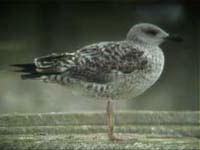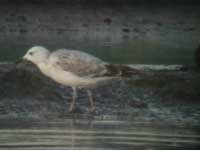surfbirds.com
(Click on any of the thumbnails on the left for a larger image and more text).
Juvenile Caspian Gull Larus cachinnans

Summary of Important Features
Size, structure and behaviour
• The head is proportionately quite small and pear-shaped, showing the characteristic snouty look of cachinnans, which is further enhanced by the long and slim bill - I liken it to that of a Slender-billed Gull Larus genei. The nape may appear to have a slight crest, or square shape to it.
• The chest is high and proud, extending on to a rounded belly.
The wings and body are long, with the flat back lacking the more prominent tertial-step of argentatus and the primary extension stretches well beyond the tail tip. The primaries themselves look thin.
When swimming, the wing points are held high, making it look like a large phalarope.
Standing, the legs are very long compared with argentatus (in flight almost reaching the tail tip) and from the front thinner; the feet also look big.
In flight, cachinnans takes on a much more commanding appearance: long and broad wings produce a strong flight, with the wings looking more pointed than juvenile argentatus; the neck is longer and the breast seems to bulge.
Plumage
There are subtle but clear distinguishing features which, alongside the structural features, are very important.
Head
• Compared directly with juvenile argentatus, the head is notable for being much paler, virtually unmarked white from a distance, but sparse and fine brownish grey streaks are visible on the rear crown and ear coverts (tightly around the eye, highlighting narrow eye crescents). These marks strengthen onto the nape and hind neck. The lores and area around the bill are unmarked.
Mantle and scapulars
• From a distance these are an even faded sepia grey (the colour of wet mud), but close to they appear all neatly fringed with a thin cream-white edge, totally lacking any notching, similar to that of a juvenile Common Gull L. canus. There may be newly moulted scapulars, showing as black diamonds with broad white tips near the neck or as black bases connected to narrow sub-terminal anchor mark by a black shaft.
Wing coverts
• Similarly marked to the mantle, with sepia-grey centres and neat off-white fringes, these become darker on the marginal coverts. The median and greater coverts are more broadly tipped whitish, with the inner greater coverts showing characteristic internal pale markings, similar to some graellsii - this marking is totally different the strongly notched inner greater coverts of argentatus or michahellis. When very fresh, the remaining greater coverts are tipped broadly off-white, which extend up the outer edge, narrowing towards the base and towards the outer wing. The overall effect of the mantle, scapulars and coverts is, from a distance, that off an even brownish grey.
Tertials
• Contrastingly black, with neat white edges (thumbnails) at the tips, but occasionally with faint, pale internal marks near the tip.
In flight
• The upper wing seems generally quite pale with two darker wing bars formed by the dark bases and pale tips of the median and greater coverts. These contrast with the black secondary bar. The inner primaries are paler than the outer forming a pale window, much paler than that of graellsii and michahellis.
Underparts
• Unmarked white, but on the breast sides and narrowly along the flanks there are usually brownish blotches or crescents. Head on these may form a broken pectoral band, but are still distinctly whiter than argentatus and most graellsii. The undertail coverts are marked by neat, yet sparse black diamonds or crescents.





